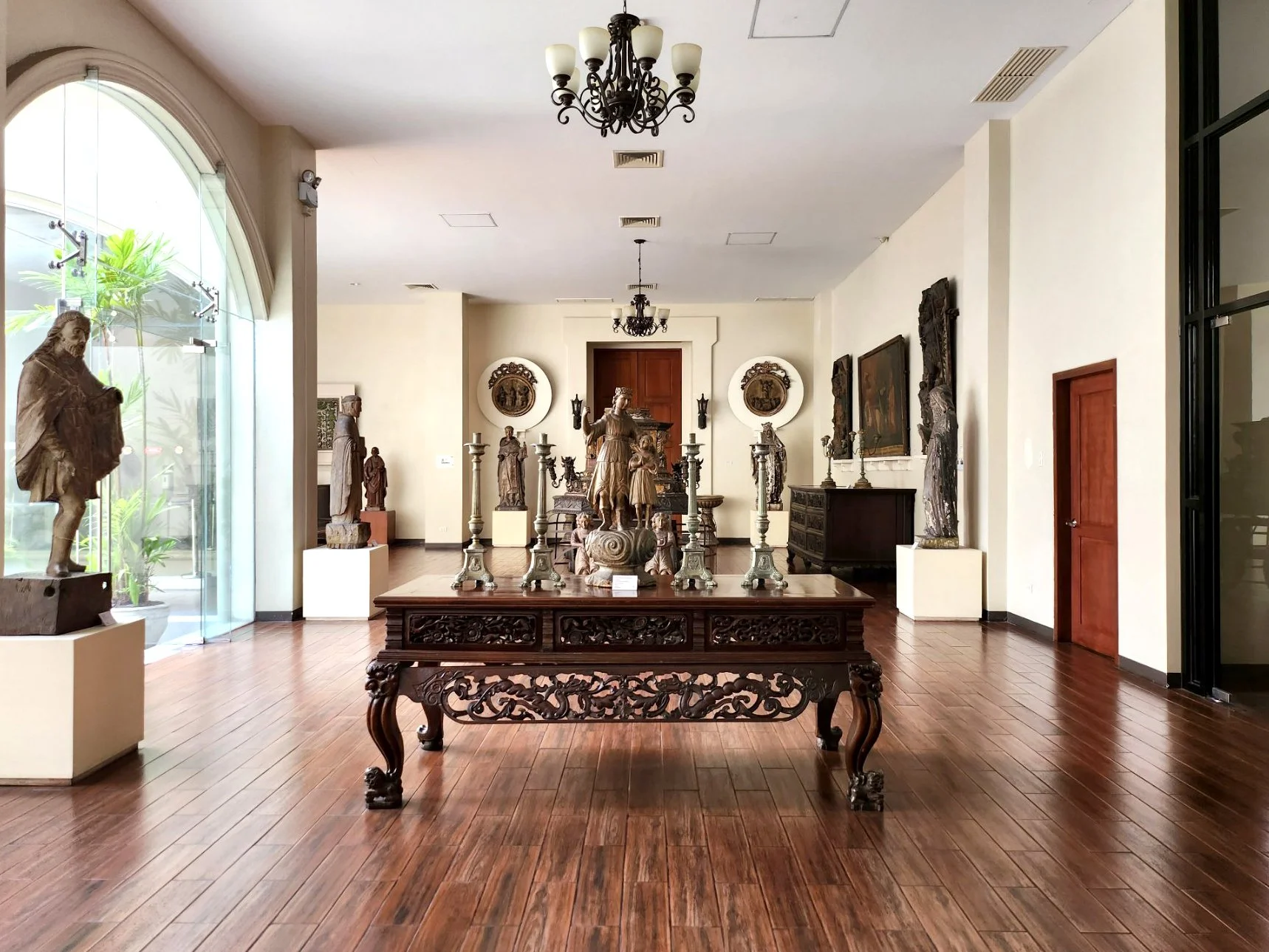Repurposing Historic Gems
Exploring the significance of adaptive reuse in Philippine heritage conservation.
By Kinah Baguan
July 24, 2023
Casa Manila’s patio and zaguan
The historic walled city of Intramuros is one of the hidden gems in the chaotic city of Manila, known for its UNESCO world heritage sites. It was built by the Spanish colonial government in the 16th-century as a defensive fortress and served as the center for political, religious, and economic power in the Philippines during the Spanish colonial period. Today, Intramuros has become a thriving space for heritage conservation and tourism developments led by the Intramuros Administration.
Apart from the nostalgia of the preserved old buildings, what does it tell us about our present understanding of Filipino heritage?
Scholars in the field of architecture and related disciplines like art history believe that by preserving our past, our built heritage can be conserved through the successful marriage of existing heritage structures and cutting-edge architectural design (Bullen 2011, Pintossi 2023).
Inside Casa Manila: the caida (ante-sala)
This school of thought is evident in adaptive reuse or the process of reusing an old site or building for a purpose other than which it was built or designed for. Where a building can no longer function with its original use, a new use through adaptation may be the only way to preserve its heritage significance. This architectural practice is evident in many successful and well-known museums—Musee D'Orsay in Paris, Tate Modern in London, Macro in Rome, and Museo ABC in Madrid, amongst others. It has been an effective way of reducing urban problems and environmental impact (Yung et al. 2012, Abdulameer et. al 2020, Foster 2020).
Located inside the walled city, Casa Manila and Museo de Intramuros are newly retrofitted heritage museums. Both offer a glimpse into the rich history and cultural heritage of the Philippines.
Casa Manila is a Spanish colonial-style house that recreates the Spanish lifestyle during the 19th century. Looking through it, the house is quite similar to typical ilustrados’ houses featured in the popular GMA Drama Series: Maria Clara and Ibarra. The facade of Casa Manila was patterned after a house that once stood at Jaboneros Street in the Chinese district of Binondo in the 1850s. The interior decor of the house follows the taste of the era where furniture, collections of portraits and memorabilia, and religious sacramentals were sourced from Europe and China. Painted walls, crystal chandeliers, carved traceries, Chinese ceramics, and gilded furniture show the elegance and luxury of a 19th-century Manila house.
The ground floor of Museo de Intramuros
Museo de Intramuros, on the other hand, is a museum that showcases the local artistry, faith, and devotion of the common Filipino. The museum is the former San Ignacio Church and the Mission House of the Society of Jesus. As the name denotes, the complex now houses the vast ecclesiastical collections of the Intramuros Administration. First built in 1878 by the Society of Jesus and completed in 1889, the San Ignacio Church, according to contemporaries, was said to be one of the most beautiful in Old Manila. Miller (1906), who called it the “jewel of Intramuros,” described its interior as “ravishingly beautiful.” Kemlein (1908) stated that “the charming splendor of this church will never fail to make the deepest impression upon the visitor,” while O’Reilly (1940) wrote that “nowhere in the Islands will more excellent wood carvings be found than here.”
The church was the masterpiece of Old Manila’s greatest artists. Don Felix Roxas, reputedly the most famous architect of the day, designed the structure, while grandmasters such as Isabelo Tampinco, Crispulo Hocson, Agustin Saez, and Manuel Flores (woodworks), Francisco Rodoreda (marble works), and Hilario Sunico (metalworks) painstakingly decorated the interior and exterior of the building. It was, however, destroyed during the Second World War, and its surviving ruins were adaptively reused as a commercial office building.
Its acquisition by the government through the Intramuros Administration in 1981 marked a renewed period of possibility. The reconstruction of the church was the goal, and this vision was realized in 2013 when the first cornerstones for the reconstruction were laid. The project signaled not just an important step in the development of Intramuros as a monument to the Hispanic era of Philippine history, but was also an important milestone in the promotion of the country’s rich ecclesiastical heritage. In 2018, the reconstruction of the Mission House was completed and was finally opened to the public in 2019 on the occasion of the 40th Anniversary of the Intramuros Administration.
While adaptive reuse has been an architectural approach in both museums, some scholars do not subscribe to this as it blurs the line between renovation, facadism, and demolition. Apart from this, there are several challenges related to the understanding of adaptive reuse and contemporary heritage, including:
Preservation vs. Development. There is often a tension between preserving heritage buildings and structure and meeting the demands of modern developments. More often than not, in the case of the Philippines, few heritage infrastructures are not seen as valuable as older heritage sites. Hence, these are often left behind or demolished, particularly if they are not bound by heritage laws.
Sustainability. Adaptive reuse can be a sustainable way to repurpose existing buildings and structures, but it is important to ensure that the new use is sustainable in itself. This may require significant changes to the building’s design or infrastructure, which can be difficult to achieve without compromising its heritage value.
Financial Viability. Adaptive reuse is an expensive process since only a few contractor companies in the Philippines offer expertise in assessing and retrofitting heritage buildings. Further, the cost of renovation may be prohibitive for many property owners.
Lack of understanding. Despite numerous studies on heritage both locally and globally, the Filipino’s understanding of contemporary heritage is often trivial, only limited to “experts” and/or enthusiasts in the field. In the Philippines, only the Intramuros Administration through their Intramuros Studies program has successfully engaged their community to raise awareness of the relevance of conservation of these heritage sites. In that way, other stakeholders (e.g. local tour guides) will be empowered to tell their narrative and identity not just as a Manileño, but also a Filipino.
Overall, adaptive reuse and the understanding of contemporary heritage require a delicate balance between preserving the past and meeting the needs of the present and future. This requires collaboration between property owners, developers, heritage experts, and the wider community to ensure that heritage sites are valued, protected, and repurposed in a way that benefits everyone.
Casa Manila is located at Plaza San Luis Complex, General Luna, corner Real Streets, Intramuros, Manila. Opening hours are Tuesdays to Sundays, 9 am to 6 pm. Museo de Intramuros is located at Arzobispo corner Anda Streets, Intramuros, Manila. Opening hours are Tuesdays to Sundays, 9 am to 5 pm. For more information on the updated rates and guided tours, email tourism@intramuros.gov.ph or business@intramuros.gov.ph.
References
1Bullen, P.A. and Love, P.E.D. (2011), "Adaptive reuse of heritage buildings'', Structural Survey, Vol. 29 No. 5, pp. 411-421. https://doi.org/10.1108/02630801111182439
2N. Pintossi, D. Ikiz Kaya, A. Pereira Roder Cultural heritage adaptive reuse in Salerno: Challenges and solutions, City, Culture and Society, Volume 33, 2023, https://doi.org/10.1016/j.ccs.2023.100505.
3Zahraa Adil Abdulameer and Sana Sati' Abbas 2020 IOP Conf. Ser.: Mater. Sci. Eng. 881 012010 DOI 10.1088/1757-899X/881/1/012010
4Esther H.K. Yung, Edwin H.W. Chan, Implementation challenges to the adaptive reuse of heritage buildings: Towards the goals of sustainable, low carbon cities, Habitat International, Volume 36, Issue 3, 2012, Pages 352-361, https://doi.org/10.1016/j.habitatint.2011.11.001
5Gillian Foster, Circular economy strategies for adaptive reuse of cultural heritage buildings to reduce environmental impacts, Resources, Conservation and Recycling, Volume 152, 2020, https://doi.org/10.1016/j.resconrec.2019.104507.



